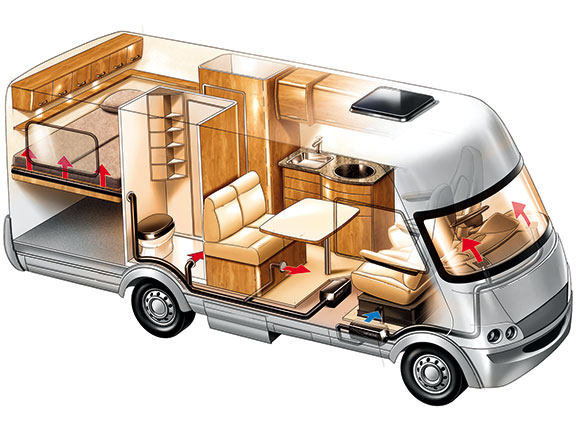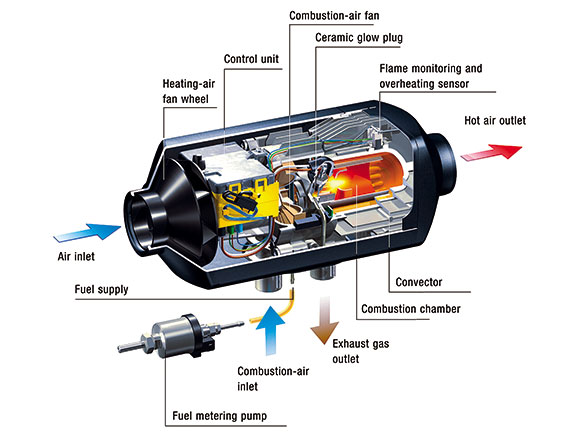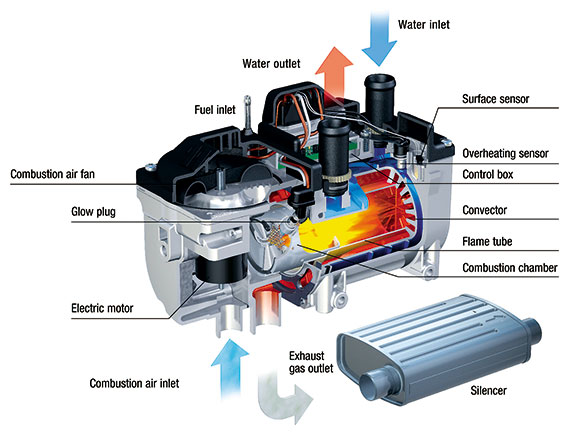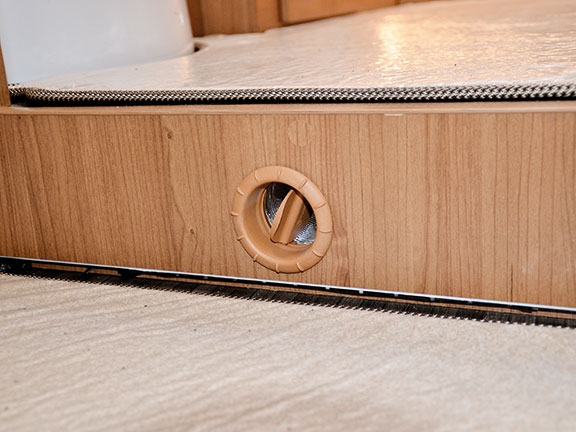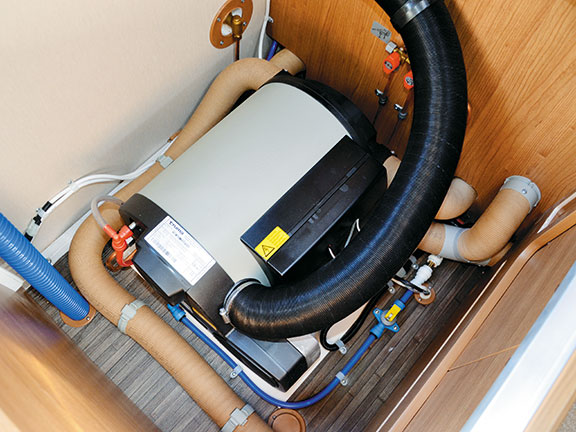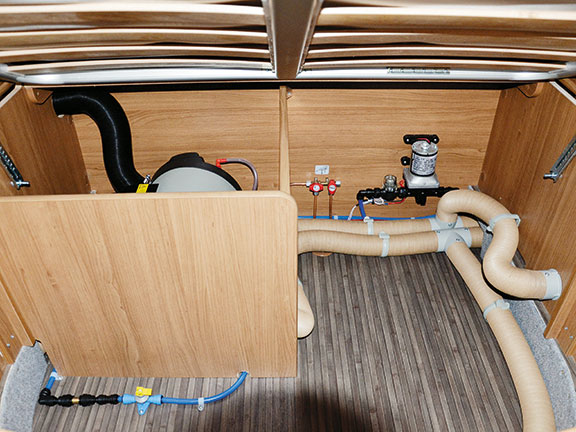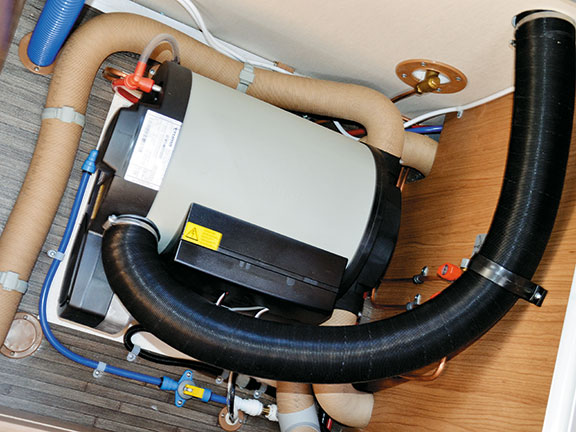Two types of air-blown heating systems, LPG and diesel, dominate the RV market. While each has pros and cons, it could be argued that very little differentiates them — in the end it simply comes down to personal preference. Here's an overview...
LPG systems
LPG is the less-complicated of the two technologies, and easier to install. Supporters point to its convenience — most RVs already use gas (for cooking/hot water) — so you won't need a new, separate fuel source.
LPG heaters have a reputation for easy, fuss-free operation: less than a second to fire up and, connected to a thermostat, they cycle on and off quickly as the temperature drops/climbs. They draw very little electrical current and are maintenance-free. Depending on who you ask, they run silently (or almost) and won't disrupt romantic dinners or sleep.
On the debit side, the main issue is fear. Many RV owners are nervous about bringing a dangerous gas into the vehicle — even though New Zealand regulations require the installation to be inspected and approved by a qualified gas-fitter. In reality, this also means the gas-fitter often does the entire job, eliminating the DIYer and thus adding to the cost.
Finally, in remote parts of the country, refills aren't always readily available.
Diesel systems
Unless you have a petrol-powered vehicle, a diesel heater draws fuel from the RV's existing tank and is easy to hook up. Unlike LPG, a refill doesn't require a bottle-swap, and even remote villages tend to have a diesel bowser.
Depending on whom you ask, diesel heaters are even more frugal than LPG heaters and the fuel is perfectly safe. Diesel vapour is smelly but breathing it won't book you an early appointment at the Pearly Gates.
On the debit side, they have a reputation for being noisy and requiring regular maintenance. Performance can be compromised by an excessive build-up of soot on the internal bits. They also draw a lot more electrical current (at start-up), take longer to fire up, and the on/off cycling can be a bit finicky.
Furthermore, unlike LPG, diesel can go 'off' if the RV is used infrequently — stale diesel may compromise the heater's operation.
By blowing hot air to various parts of the RV, both types have one common disadvantage. In thermal efficiency terms, hot air isn't the most effective heating medium. It cools quickly and depending on the length of the ducting (i.e. the size of the vehicle) the air arriving at the furthest outlet might not be quite as warm. Regulating the heat at different outlets can also be tricky — adjustment often relies on a simple, louvered vent.
With all that in mind, I asked Robert Ferguson (business development manager at Auckland's Dometic Group) for a few pointers to help DIYers assess both systems. Dometic distributes Germany's Eberspächer and Truma heaters — both LPG and diesel.
Heater size/output
The average six- to seven-metre RV, says Ferguson, uses a heater rated at between two and four kilowatts. “While the RV's size tends to dictate the heater's output, an important consideration is the number of outlets.
“If you plan to install additional outlets — say in a bathroom and through a towel rail — you'll want the bigger unit. Most retailers sell complete kits for a basic installation, and if you want to add extras, installing more ducting with additional T- and Y-joints, the heater will have to work harder.”
Where you intend to travel also affects size — North Island RVs won't need as big a unit as those in the deep South.
The RV's batteries — as well as the charging system — are also factors. “LPG and diesel heaters both draw very little current in standard operating trim. Dometic's Truma E2400 (LPG), for example, has a rated output of 2.4kW at high power and 1.2kW at low power — drawing 1.1A and 0.6A respectively.
“But where LPG units will operate with batteries that are less than fully-charged — a not uncommon situation for freedom campers — diesel heaters might be compromised. They function better with topped-up batteries.”
The issue, he explains, relates to the diesel-heater's glow plug. It needs to reach 1200oC to ignite the raw diesel fuel. Poorly-charged batteries can't deliver the required grunt. And when diesel's squirted on to a luke-warm glow plug, sooting can develop.
The problem's exacerbated if the diameter (gauge) of the diesel heater's electrical feed wire is too thin — a common fault with DIY installations. “Every wire creates resistance. If it's too thin the resistance increases — and the problem's compounded if the voltage is already low.”
An easy fix is starting the motorhome's engine before firing up the diesel heater.
Noise
Heater noise is often a function of ducting size (usually 60mm – 80mm in diameter). “It stems from the friction of air travelling along the ducting — and as a general rule, go for bigger rather than smaller. Bigger ducting offers a high volume of air at low velocity (less friction), rather than a smaller volume of air travelling at a high velocity.”
It's worth noting that gas heaters (with their low electrical consumption) are particularly suited for caravans. Caravans are less likely to have large-capacity batteries, and they typically don't have an on-board charging system.
Electrical load
Heaters cycle on and off based on the temperature set on a wall-mounted thermostat. LPG heaters react easily and quickly — they switch off when the set point is reached and the flame goes out. When the temperature falls two or three degrees they automatically fire up again (within half a second). Electrical load at each start-up is around one amp.
By contrast, a diesel heater's cycling operation is much more ponderous. The start-up process is much longer — around 140 seconds — and it draws around eight to ten amps because the glow plug has to be heated to the right temperature. Diesel heaters don't like repeated shut-offs and start-ups, so the flame never goes out.
As the temperature inside the RV rises, the heater throttles back its output automatically. When the temperature falls below the set point, the heater fires up again.
“Where a typical LPG heater's modulation (margin for cycling on/off) is about two or three degrees, a diesel heater's is about five degrees. A useful tip is to set a diesel heater's thermostat a little higher than you desire — the temperature fluctuations won't be as noticeable.”
Hydronic systems
A third type of RV heating technology — the water-based Hydronic system — is more expensive (and more complicated) than the LPG and diesel heaters, but more thermally efficient. Water is heated and pumped around the RV to radiators and fan/matrix units at each outlet. Water retains its heat much more effectively than air, so there's less temperature loss.
The Hydronic system's water piping (22mm) is much easier to route through an RV than 60mm or 80mm ducting, but it involves quite a bit more plumbing and electrical connections.
Installation
All three heating systems are available as ready-to-go kits — but there are a few installation issues to consider. The diesel kits are supplied with an independent fuel pick-up that's inserted into the RV's tank. “I don't recommend teeing-off the engine's existing fuel line,” warns Ferguson. “The engine's lift pump may suck the fuel from the heater, introducing air into the engine line, leaving you with a dead RV.”
Vents should be mounted near floor level (hot air rises), and try to minimise severe bends in the ducting. Every bend/joint represents increased friction. Straighter is better.
Prices for the kits vary considerably, so shop around. Expect to pay around $2200 for an LPG kit, $2700 for a diesel kit and $3000 for a Hydronic kit. The latter also requires additional fan/matrix units (around $600 each) on top of the base price.
Combo units
A relatively recent arrival, combo units are a water heater and air heater integrated into one system — it heats the van's interior as well as water for the bathroom/kitchen. They can be powered by LPG or diesel — as well as 240 volts. The key advantages are compact size and single installation — not cost. Dometic's new Truma Combi, says Ferguson, costs about the same as two separate systems.
So which heater?
Up to you.
Dometic's sales in the RV market, says Ferguson, reflect a 50:50 split between LPG and diesel — and the vast majority are sold through referral.
“People buy a system on the recommendation of a friend. My best advice to the DIYer is this: talk to others in your motorhome or caravan club. See what they're using and ask if they're satisfied with the performance. Personal experience is the best endorsement.”
For the latest reviews, subscribe to our Motorhomes, Caravans & Destinations magazine here.

RV maintenance: prepare your RV for winter
Protect your motorhome this winter with expert winter maintenance tips tailored for New Zealand conditions

